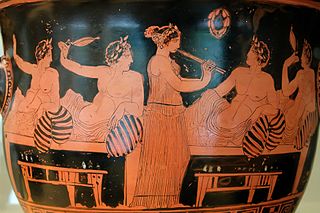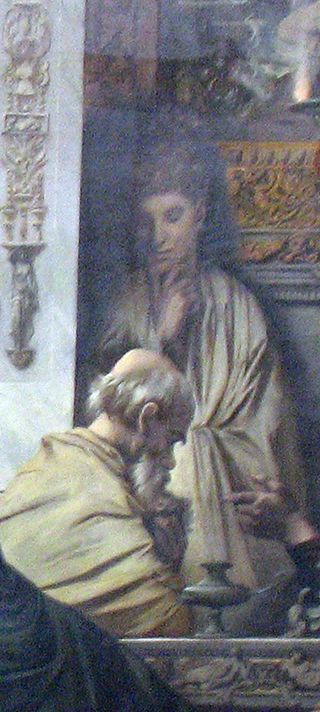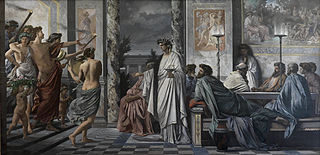The symposium was an Ancient Greek social institution.
Symposium may also refer to:
The symposium was an Ancient Greek social institution.
Symposium may also refer to:

Agathon was an Athenian tragic poet whose works have been lost. He is best known for his appearance in Plato's Symposium, which describes the banquet given to celebrate his obtaining a prize for his first tragedy at the Lenaia in 416. He is also a prominent character in Aristophanes' comedy the Thesmophoriazusae.

Xenophon of Athens was a Greek military leader, philosopher, and historian, born in Athens. At the age of 30, Xenophon was elected commander of one of the biggest Greek mercenary armies of the Achaemenid Empire, the Ten Thousand, that marched on and came close to capturing Babylon in 401 BC. As the military historian Theodore Ayrault Dodge wrote, "the centuries since have devised nothing to surpass the genius of this warrior". Xenophon established precedents for many logistical operations, and was among the first to describe strategic flanking maneuvers and feints in combat.

Akseli Gallen-Kallela was a Finnish painter who is best known for his illustrations of the Kalevala, the Finnish national epic. His work is considered a very important aspect of the Finnish national identity. He changed his name from Gallén to Gallen-Kallela in 1907.

Xanthippe was an ancient Athenian, the wife of Socrates and mother of their three sons: Lamprocles, Sophroniscus, and Menexenus. She was likely much younger than Socrates, perhaps by as much as 40 years.

Aspasia was a metic woman in Classical Athens. Born in Miletus, she moved to Athens and began a relationship with the statesman Pericles, with whom she had a son, Pericles the Younger. According to the traditional historical narrative, she worked as a courtesan and was tried for asebeia (impiety), though modern scholars have questioned the factual basis for either of these claims, which both derive from ancient comedy. Though Aspasia is one of the best-attested women from the Greco-Roman world, and the most important woman in the history of fifth-century Athens, almost nothing is certain about her life.

Anselm Feuerbach was a German painter. He was the leading neoclassical painter of the German 19th-century school.
The Sacred Band of Thebes was a troop of select soldiers, consisting of 150 pairs of male lovers which formed the elite force of the Theban army in the 4th century BC, ending Spartan domination. Its predominance began with its crucial role in the Battle of Leuctra in 371 BC. It was annihilated by Philip II of Macedon in the Battle of Chaeronea in 338 BC.

In historical scholarship, the Socratic problem concerns attempts at reconstructing a historical and philosophical image of Socrates based on the variable, and sometimes contradictory, nature of the existing sources on his life. Scholars rely upon extant sources, such as those of contemporaries like Aristophanes or disciples of Socrates like Plato and Xenophon, for knowing anything about Socrates. However, these sources contain contradictory details of his life, words, and beliefs when taken together. This complicates the attempts at reconstructing the beliefs and philosophical views held by the historical Socrates. It has become apparent to scholarship that this problem is seemingly impossible to clarify and thus perhaps now classified as unsolvable. Early proposed solutions to the matter still pose significant problems today.

Socratic dialogue is a genre of literary prose developed in Greece at the turn of the fourth century BC. The earliest ones are preserved in the works of Plato and Xenophon and all involve Socrates as the protagonist. These dialogues, and subsequent ones in the genre, present a discussion of moral and philosophical problems between two or more individuals illustrating the application of the Socratic method. The dialogues may be either dramatic or narrative. While Socrates is often the main participant, his presence in the dialogue is not essential to the genre.

In Ancient Greece, the symposium was a part of a banquet that took place after the meal, when drinking for pleasure was accompanied by music, dancing, recitals, or conversation. Literary works that describe or take place at a symposium include two Socratic dialogues, Plato's Symposium and Xenophon's Symposium, as well as a number of Greek poems, such as the elegies of Theognis of Megara. Symposia are depicted in Greek and Etruscan art, that shows similar scenes.
The Apology of Socrates to the Jury, by Xenophon of Athens, is a Socratic dialogue about the legal defence that the philosopher Socrates presented at his trial for the moral corruption of Athenian youth; and for asebeia (impiety) against the pantheon of Athens; judged guilty, Socrates was sentenced to death.

The Symposium is a Socratic dialogue written by Xenophon in the late 360s B.C. In it, Socrates and a few of his companions attend a symposium hosted by Kallias for the young man Autolykos. Xenophon claims that he was present at the symposium, although this is disputed because he would have been too young to attend. The dramatic date for the Symposium is 422 B.C.
Ad astra (phrase) is a Latin phrase meaning "to the stars", and the motto of several organizations

Crito of Alopece was an ancient Athenian agriculturist depicted in the Socratic literature of Plato and Xenophon, where he appears as a faithful and lifelong companion of the philosopher Socrates. Although the later tradition of ancient scholarship attributed philosophical works to Crito, modern scholars do not consider him to have been an active philosopher, but rather a member of Socrates' inner circle through childhood friendship.
Hermogenes was an ancient Athenian philosopher best remembered as a close friend of Socrates as depicted by Plato and Xenophon.

Socrates was a Greek philosopher from Athens who is credited as the founder of Western philosophy and among the first moral philosophers of the ethical tradition of thought. An enigmatic figure, Socrates authored no texts and is known mainly through the posthumous accounts of classical writers, particularly his students Plato and Xenophon. These accounts are written as dialogues, in which Socrates and his interlocutors examine a subject in the style of question and answer; they gave rise to the Socratic dialogue literary genre. Contradictory accounts of Socrates make a reconstruction of his philosophy nearly impossible, a situation known as the Socratic problem. Socrates was a polarizing figure in Athenian society. In 399 BC, he was accused of impiety and corrupting the youth. After a trial that lasted a day, he was sentenced to death. He spent his last day in prison, refusing offers to help him escape.

Aristodemus of Cydathenaeum was an ancient Athenian follower of the philosopher Socrates. He is best remembered as a character and narrative source in Plato's Symposium, and is also preserved in Xenophon's Memorabilia and a fragment from Aristophanes.

Symposium or Das Gastmahl des Platon are paintings by the German painter Anselm Feuerbach from c. 1869 and 1873/74 of a moment from Plato's Symposium, when the drunken Alcibiades and revelers enter the house of the poet Agathon. Socrates, near the wall at right-centre, turns his back on the scene, and bows his head.

Parisian Backyard is an oil-on-canvas painting executed in 1884 by Finnish artist Akseli Gallen-Kallela. The work is 28 × 23 cm in size and belongs to the Ateneum, part of the Finnish National Gallery in Helsinki, where it was donated in 1945.

Symposium is an oil painting created by Akseli Gallen-Kallela in 1894.